- What is a Mental Health App?
- Digital Revolution of Mental Health
- Number and Varieties of Therapy Applications
- Key Statistics on Mental Health Apps
- Top 5 Mental Health Apps In 2023
- Must-have features of Mental Health Apps
- Advantages to a Business for Developing Mental Health App
- Monetization Strategies for Mental Health Apps
- Mental Health App Development Best Practices
- How to Develop a Mental Health App
- Critical Feedback Insights for Mental Health Apps
- Key Challenges Faced by Mental Health Apps
- Cost of Developing a Mental Health App
- Conclusion-
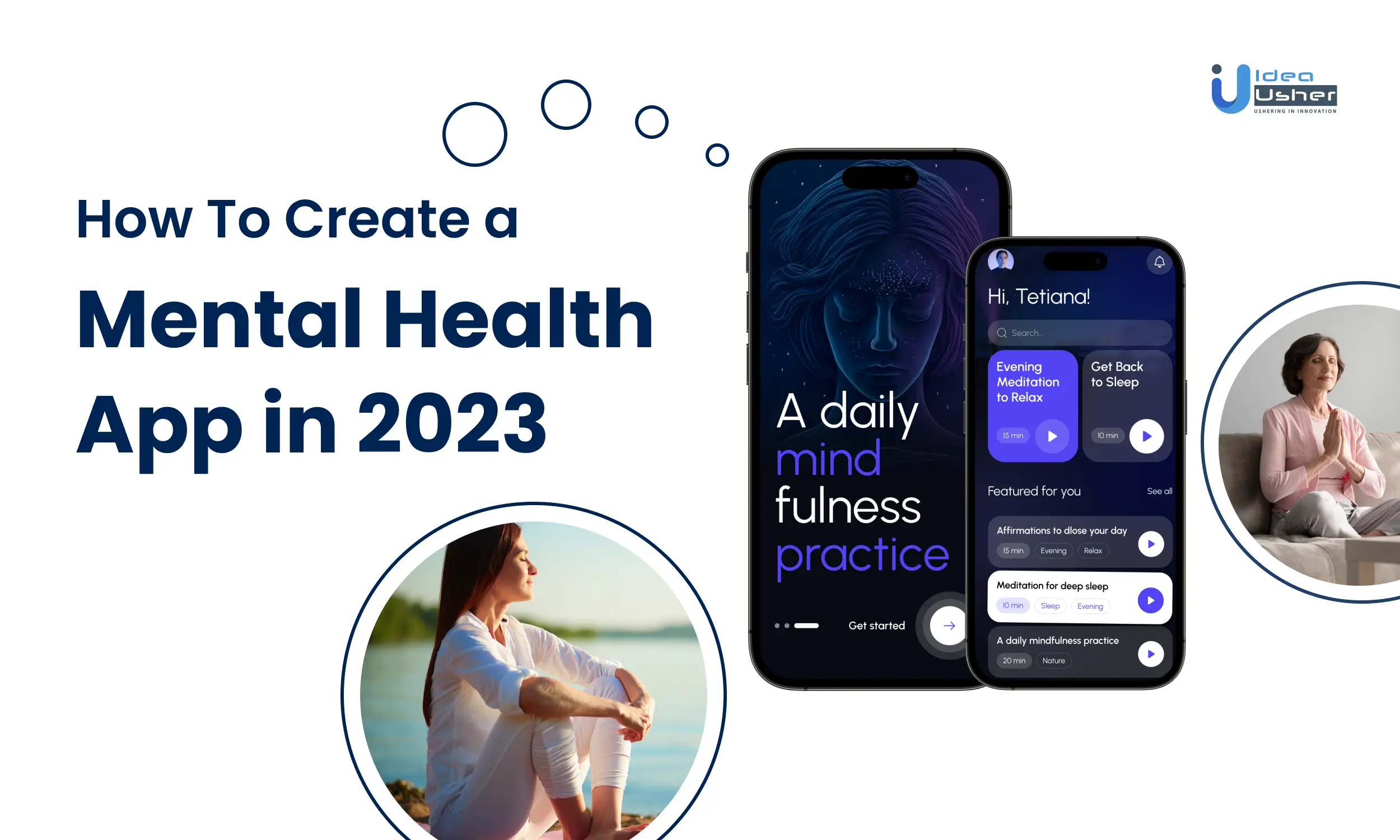
In the ever-evolving landscape of technology, app developers play a pivotal role in shaping the way we navigate and enhance our lives. One area that holds tremendous promise is the realm of mental health. As more individuals prioritize their well-being, the demand for innovative and user-friendly mental health apps continues to surge.
This blog is about the intricacies of building a mental health app along with offering valuable insights as well as practical guidance to help turn your ideas into reality. Through the power of smartphones, mental health apps have the potential to reach vast audiences, delivering personalized support and empowering tools to improve mental resilience.
From mindfulness exercises and mood tracking to cognitive behavioral therapy and stress management techniques, these apps offer diverse features catered to individual needs. Embarking on the journey of developing a mental health app requires a strategic blend of careful planning, human-centered design, and technical prowess.
Join us as we delve into the exciting world of mental health app creation, unveiling the crucial steps, considerations, and industry best practices that will equip you to build an app that can revolutionize mental well-being support.
- What is a Mental Health App?
- Digital Revolution of Mental Health
- Number and Varieties of Therapy Applications
- Key Statistics on Mental Health Apps
- Top 5 Mental Health Apps In 2023
- Must-have features of Mental Health Apps
- Advantages to a Business for Developing Mental Health App
- Monetization Strategies for Mental Health Apps
- Mental Health App Development Best Practices
- How to Develop a Mental Health App
- Critical Feedback Insights for Mental Health Apps
- Key Challenges Faced by Mental Health Apps
- Cost of Developing a Mental Health App
- Conclusion-
What is a Mental Health App?
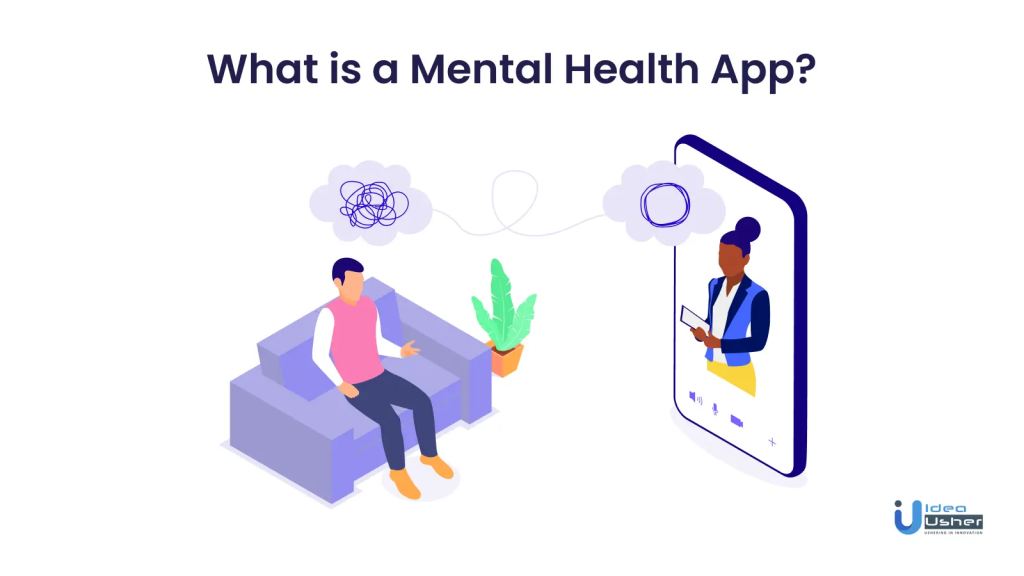
A mental health app is a software application designed to support individuals in managing their mental well-being, offering tools and resources to users to improve mental health and overall emotional well-being.
Such apps can be used and accessed via smartphones, tablets, and other such digital devices.
Apart from this, mental health apps provide a wide array of features and functionalities that vary per the app’s purpose and target audience. Some features commonly found in mental health apps are mood tracking, meditation, and relaxation techniques, self-assessment and screening, journaling and thought recording, etc.
Digital Revolution of Mental Health
The emergence of the digital revolution has changed the landscape of the field of mental well-being and the delivery of mental health support. Technology has brought numerous advancements and benefits to the field of mental health such as increased accessibility to mental health support, personalized interventions and self-management of mental well being, offering valuable insights into users’ well-being patterns, privacy and anonymity by digital mental health platforms, etc.
Number and Varieties of Therapy Applications
The number of mental health apps available varies across platforms, ranging from 1,435 to 10,000 to 20,000, depending on the inclusion of self-help and meditation apps. The most common types of mobile therapy products include:
- Teletherapy applications
- Chatbots
- Self-improvement solutions
- Mood & symptoms tracking apps
- Educational healthcare services
- Psychological therapy app development
These applications address various mental conditions such as:
- anger management, anxiety management
- meditation apps with breathing exercises
- drinking and eating disorder apps
- motivation and general mental health apps
- obsessive compulsive disorder (OCD)
- panic attacks, stress management
Key Statistics on Mental Health Apps
- The global mental health apps market was valued at USD 5.2 billion in 2022 and is projected to grow at a CAGR of 15.9% from 2023 to 2030, according to Grand View Research.
- More than 1 in 5 adults in the United States live with a mental illness.
- Over 1 in 5 youth (ages 13-18) have experienced a seriously debilitating mental illness, either currently or at some point in their lives.
- Approximately 1 in 25 U.S. adults lives with a serious mental illness, such as Schizophrenia, Bipolar Disorder, or major Depression.
- The North American region dominates the mental health apps market, accounting for the highest revenue.
- The increasing demand for virtual treatment in the mental health apps market has been influenced by contemporary lifestyles and fast-paced lives.
- These points highlight the market growth, prevalence of mental illnesses, and the impact of mental health apps, particularly in the North American region.
Top 5 Mental Health Apps In 2023
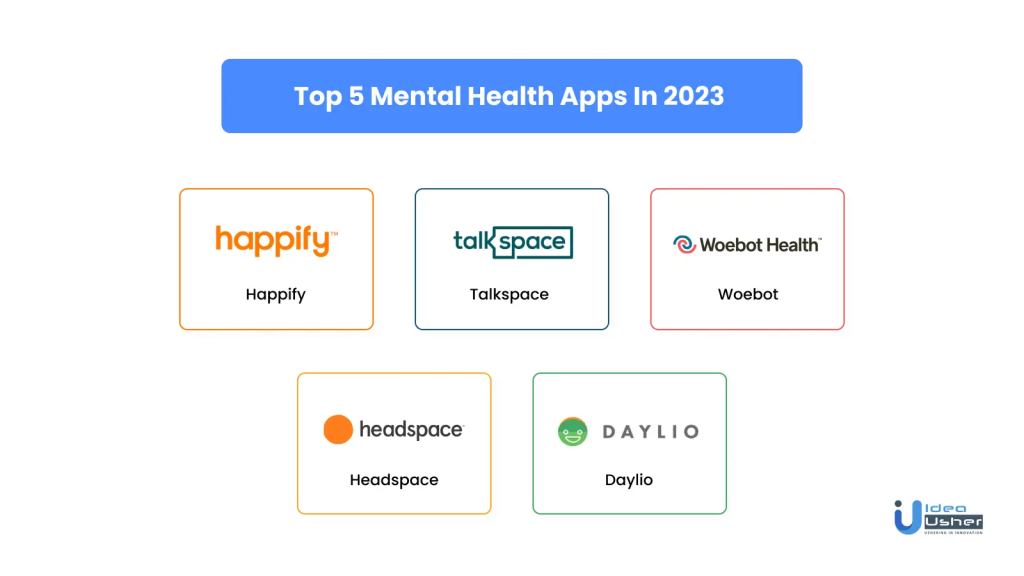
1. Happify
Happify is a leading mental health app that aims to improve users’ happiness. It offers a variety of features, including mini-games, meditation, and mental health tracking, all designed to help users enhance their well-being. By combining these elements, Happify strives to support users in their journey towards greater happiness and overall mental well-being.
2. Talkspace
Talkspace is a comprehensive telemedicine platform and marketplace that facilitates the connection between patients and therapists. It provides a convenient and effective way for patients to find a suitable therapist and access online therapy sessions through messaging, audio calls, or video consultations. Through Talkspace, individuals can easily connect with licensed therapists and receive the therapy they need in a flexible and accessible manner.
3. Woebot
Woebot is a widely recognized chatbot service designed to assist individuals in managing anxiety and depression. It functions as a patient-focused app that utilizes AI-powered communication to provide support. In addition to its chatbot capabilities, Woebot offers valuable features such as mood tracking and engaging word games, enabling users to actively manage their mental health. With Woebot, individuals can access resources and tools that contribute to their well-being while receiving personalized support.
4. Headspace
Headspace is a meditation app that offers a comprehensive solution for individuals seeking mindfulness and relaxation. With a wide range of meditations tailored to various activities and audiences, Headspace provides users with a versatile meditation experience. The app not only helps users establish and track their meditation practice but also sends reminders for scheduled sessions. Furthermore, Headspace includes community features such as group meditations, allowing participants to engage in shared mindfulness experiences regardless of distance. Additionally, the app offers a mood tracker to help users monitor and understand their emotional well-being.
5. Daylio
Daylio falls into the category of self-awareness and self-assessment apps, providing users with a platform to introspect and evaluate their mental health. This app serves as a self-care journal equipped with mood tracking and a happiness tracker. Users can monitor their moods in relation to their daily activities, gaining insights into how different factors influence their well-being. By reviewing this information, individuals can better understand the impact of various aspects of their lives on their mental health.
Must-have features of Mental Health Apps
There are some core must-have features of the mental health applications:
1. User profile
When it comes to creating a personalized user experience, having a user profile can play a key role. A user profile is an application that involves various details and preferences specific to the individual user such as ‘What time do you go to bed or wake up’ or ‘How many times do you work out in a week?’ These details can influence how the app functions and tailors its features to meet the user’s needs.
2. Appointment scheduling
Your application should allow and assist patients to easily book appointments with therapists. Although, the software will support calendars native to a platform such as Google Calendar, or iCal. It also means that there must be patient lists on the back end and the ability to set and keep track of the length of therapy sessions.
3. Notifications
Notifications and reminders are another crucial feature of mental health applications. It can help patients to track their meals and medications as well as help monitor their progress and their stress levels.
4. Social networking features
App developers can also craft a live feed where users are allowed to share, comment, and vote on different topics. It can help in establishing a strong community that will motivate individuals to keep working on their mental health consistently.
5. Dashboards
Dashboards is another essential feature that allows users to keep track of their cognitive, emotional, and other health conditions.
6. Messaging
Messaging is an integral aspect of teletherapy applications as it connects therapists with remote patients for a live conversation or chat and allows them to share voice recordings as well.
7. Audio and video calling
Even though audio and video calls are more suitable features for telemedicine mental health apps, one should not forget how this feature helps in making a user experience seamless and stutter-free during video sessions. Hence it is an effective functionality to integrate.
8. AI and ML
When it comes to personalization, artificial intelligence cannot be left out because the more your application knows or learns about the users, the more easily it can adapt to its patients’ needs.
You can also choose to integrate an AI chatbot for answering typical questions and assisting patients with preliminary self-assessment.
9. Gamification
A wide array of mental health applications have gamification features. Mini-games help people with their cognitive skills training and relaxing their minds. In addition to this, another aspect where game-like elements can help are assessment tests.
10. Miscellaneous
There are a wide variety of things that you can add to your mental health application to assist people in developing healthy habits. Also, it depends on particular mental health disorders that you wish to acknowledge through your solution:
- tracking allergies, diet
- attention problems
- bipolar disorder
- LGBTQ bullying, suicide prevention
- disorder aggravation
- post traumatic stress disorder
Advantages to a Business for Developing Mental Health App
Mental health apps have a wide array of benefits for users and businesses:
1. User benefits
i. Convenient
Mental health apps are highly convenient as treatment given to users via them can take place anywhere and at any time. For example- if a patient has difficulty taking in-person appointments, then a mobile health app can be helpful whether a person requires assistance in the middle of the night or while recruiting to work.
ii. Affordable
There are still a majority of people who do not get access to mental health treatment as and when required because they live in remote areas or cannot afford medication. Therefore, lower medical costs may be an integral reason why several patients prefer mental health apps over traditional care.
iii. Anonymity
All of us are aware of the “mental health stigma” that continues to persist in our society. It refers to societal disapproval or shame towards individuals who battle mental illnesses.
To acknowledge the very issue, patients who feel discomfort while addressing their concerns over the phone can utilize a mobile mental health app. Such apps offer resources, information, and support to individuals seeking mental health treatment. The anonymity provided by these apps is a preferred choice of various patients, allowing them to gain access to help discreetly and without fear of judgment.
iv. Flexibility
The emergence of digital therapy by mental health apps offers various advantages over traditional talk therapy. One significant advantage is the increased scheduling flexibility provided by therapy apps. Unlike traditional therapy, which often requires fixed appointment times, mobile health apps enable users to access treatment whenever and wherever they require it. There, flexibility is particularly beneficial for individuals who have busy schedules or find it tough to commit to regular in-person therapy sessions.
2. Business Benefits
i. Provide more value to your patients
As technology advances, people’s expectations also increase. Mobile apps are a great way to meet these expectations. By developing a mobile app, you can make your products and services more accessible and easier to use. It means that people can easily access and utilize your offerings on their smartphones, tablets, and other devices. Therefore, mobile apps help you keep up with the evolving demands of users and provide a convenient and user-friendly experience to them.
ii. Communicate directly with customers
One of the main reasons why companies need to develop apps is to chain the gap of direct communication between clients and customers. Business mobile application development has allowed clear and direct communication between customers and businesses by offering instant access to a great amount of information at the touch of a button. The data gained from customers utilizing mental health apps are essential for any company seeking to enhance its marketing strategies.
iii. Enhance data management
Each day, healthcare organizations process huge amounts of personal data due to which its proper organization is a necessity. Healthcare apps that are instilled with Electronic Health Records (EHR) automatically record and save valuable patient health information from connected devices. It ultimately allows healthcare providers to make a comprehensive patient profile.
iv. Earn extra revenue
A mental health app provides an opportunity for medical professionals to make surplus income by giving after-hours services. It offers them the bandwidth to check on patients more than in-office face-to-face appointments. Additionally, you also get the chance to spend more time on practical tasks while utilizing remote applications and you are not required to do any documentation as most of the paperwork is done automatically. Therefore, the reduction in inefficiency leads to a higher direct run.
v. Build a stronger brand
You can develop a stronger brand and it should reflect through your application so that users can place their trust in it. Mobile apps not only strengthen your brand but also make the users aware of your app, company, and its noble purpose.
Monetization Strategies for Mental Health Apps
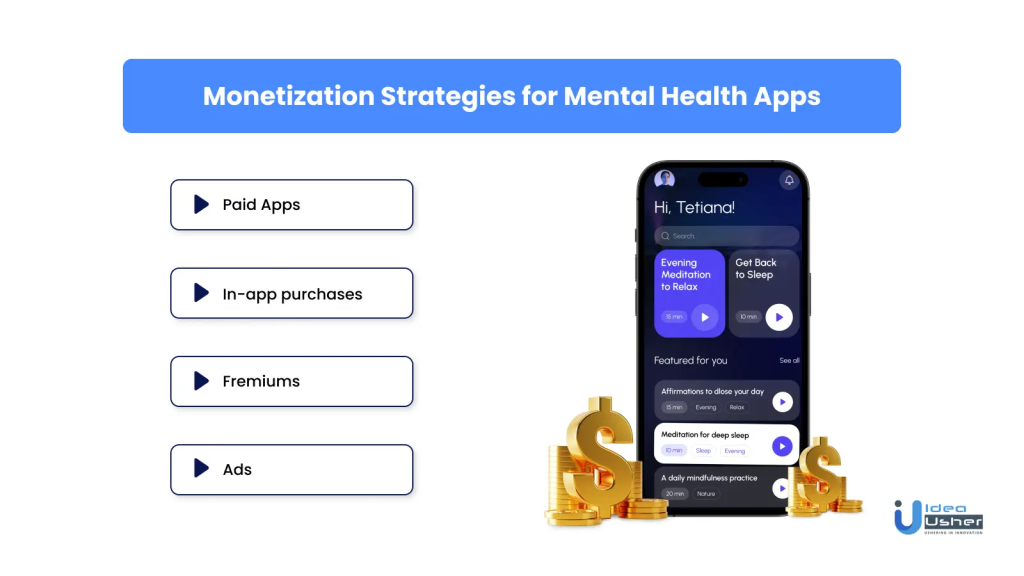
i. Paid Apps
Paid mobile apps follow an uncomplicated business strategy where users have to pay a one-time fee before they can download and utilize the app. Although, this approach has become less effective and popular with time. Nowadays, the app needs to be viewed as a high-quality product in order to become successful. One way to accomplish it is by avoiding lower pricing strategies and positioning the app as a premium offering as it helps in crafting the perception that the app is a value for money and worth the price.
ii. In-app purchases
In-app purchases, or IAP is another way through which applications generate revenue. The app and its basic features are usually free although there are additional premium features that if the users wish to gain access to, can pay for. Thus, in-app purchases offer a monetization method that is not intrusive and can enhance the user experience if your product is offered for free.
iii. Fremiums
Freemium is a model which offers a free download but involves premium features that users must pay for. The model is based on the app’s ability to attract users and allow them to try the app before paying anything.
iv. Ads
Business owners also collaborate with other brands allowing them to run advertising campaigns in their apps for which they can charge a cost-per-mile commission.
Mental Health App Development Best Practices
1. Consumer-centric design
From the app’s logo via onboarding and to main screens, the design is your primary tool through which you must establish credibility and trust.
- How smooth is the onboarding process?
- Is it immediately apparent to users what they can do in the application?
- Does the UX follow the platform trends, simplifying user interactions?
Answers to these and other similar questions will help you understand whether your application will be a success or a fail.
2. Security
Security is another necessary aspect that users care about as their personal data is at stake. Therefore, it is important to implement security measures. Besides the HIPAA compliance, you can have a transparent privacy policy and educate your users about the same. You must comply with regulatory guidelines such as GDPR in the EU, and seek guidance from the local authorities.
3. Doctor-centric back end
A doctor-centric back end is defined as the technology infrastructure that supports functionality and operations of a web or a mobile application designed for doctors or therapists. The back end is responsible for managing the data, communication as well as features that enable therapists to communicate with their patients effectively as well as review patient information.
4. Multi-platform support
These days, customers tend to shuffle between two devices- laptops and smartphones. Hence, your product should be compatible with all forms of devices.
5. Internet of medical things
Wearable devices and smartphones offer valuable data on customers’ physical activity. Monitoring this data helps in the identification of discrepancies and information on better treatment plans as a healthy mind contributes to a healthy body.
6. Cautious use of AI
AI plays a crucial role in therapy apps but it also comes with certain considerations. Training machine learning algorithms on real patient data can be challenging due to privacy concerns and the sensitive nature of therapy sessions. Thus, alternative approaches are integral to develop effective AI models for therapy apps
7. Psychiatric emergency
Finally, it is always better to remind patients that your solution is not designed for emergency situations (God forbid, suicide attempt) and provide appropriate contacts in the app for such situations. Emergency support features should be limited to a simple call button and maybe a short FAQ section and automatic notifications for family members and relatives. As for emergency messages, it is not recommended unless you can provide 24/7 service with human support.
How to Develop a Mental Health App
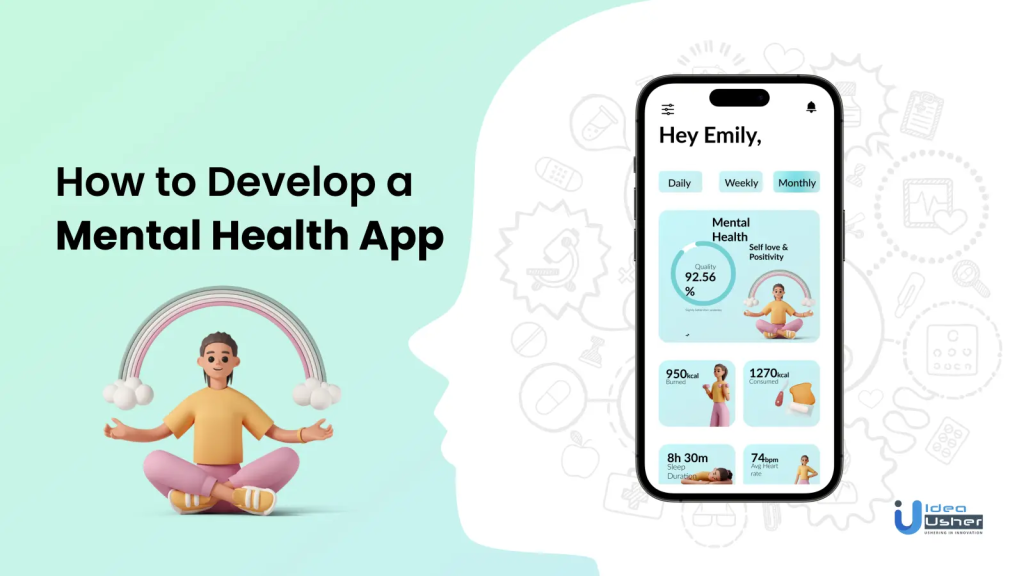
1. Market Research and Target Audience
Market research is the first and foremost toward the mental health app development process. It involves gathering information about the existing landscape of mental health apps. It involves studying the features, strengths, weaknesses, and user feedback of other competitor apps available in the market.
By analyzing existing apps you can identify trends, popular features, and areas where improvements can be made. Ultimately, the research will help you gauge an understanding of what the users are looking for in a mental health app and provide insights into the competition.
Defining your target audience includes identifying the specific group of individuals you aim to serve with your app.
It is equally important to consider the following demographics as different age groups have different mental health needs and preferences:
- Age
- Gender
- Location
Focus on the mental health needs and challenges that your app aims to acknowledge. For example, if your app’s focus is stress management for working professionals, your target audience may be individuals aged 25-40 working in high-stress environments.
Consider the preferences and technological literacy of your target audience. Some individuals may prefer simple and intuitive interfaces, while others may be more tech-savvy and open to more advanced features.
Market research and defining your target audience allows you to tailor your app’s features, design, marketing strategy to meet the specific needs and preferences of intended users.
2. Value proposition and differentiation
i. Value proposition
Your app’s value proposition is a concise statement that reflects the unique benefits and value your app offers to its users.
It should clearly communicate the problem your app aims to solve and why should users choose it over other available mental health apps in the market.
The focus of the value proposition should be the key features, functionalities, or services that make your app valuable and relevant to your target audience.
ii. Differentiation
Differentiation refers to identifying and highlighting the aspects that set your app apart from competitors.
Evaluate the existing mental health apps in the market and identify any gaps or areas where your app can provide a unique and valuable solution.
Consider the specific needs, preferences, or challenges of your target audience, that were not addressed and solved by other competitor apps.
Your differentiation could be based on user experience, user experience, specialized content, integration with wearable devices, or partnerships with mental health professionals.
iii. Addressing the needs of your target audience
It is integral to align your app’s features and functionalities with the specific needs and preferences of your target audience.
Conduct user research or surveys to gain insights into the pain points, challenges, and goals of your target audience in relation to mental health
Determine your app’s features, content as well as your user experience to directly address the needs and provide relevant solutions.
Communicate how your app understands the specific challenges of your target audience and provides effective support.
3. Collaboration with mental health professionals
Partnering or collaborating with mental health professionals is essential when developing a mental health app as their involvement brings expertise to the process and ensures the app’s effectiveness in supporting the users’ well-being.
Involving experts would allow for a deeper understanding of user needs and challenges. Experts can offer insights into evidence-based therapeutic techniques that can be implemented in the app, which would ultimately provide meaningful and effective support to users.
Apart from this, collaboration can also involve obtaining feedback on the app’s features and functionalities, validating the content present on the app, and also making sure that the app is in compliance with the best practices in the mental health field.
4. App design and user experience
Designing the user interface (UI) and the user experience (UE) is a major contributor to the application’s success. It includes creating a design that is easy to navigate through, appealing, intuitive, and user-friendly. An interface made of all these features would allow users to easily find what they need and comprehend how to use the app without facing any confusion.
Crafting a visually appealing interface helps in enhancing user engagement and satisfaction. The use of attractive colors, fonts, and graphics makes it appealing and attracts users. Additionally, it is integral to ensure that users of all disabilities can effectively and easily use the app. It involves using proper contrast, providing alternative text for images, and supports assistive technologies.
By following and implementing the best practices for UI/UX design, like employing clear navigation, consistent layouts, and utilizing valuable feedback, developers can build a mental health app that is user-friendly, intuitive, and accessible to a wide array of users.
In addition to this, it is a requirement to integrate features that promote ease of use, smooth navigation as well as personalization. Such features make it easier for users to interact with the app and find what they require quickly, and customize their experiences to suit their preferences as well as needs.
5. Ensuring data privacy and security
Ensuring data privacy and security plays an equally important role in the app development process because the mental health data gathered or collected from several patients is sensitive and must be handled with utmost care to give protection to user privacy.
Privacy concerns arise because such kind of data is personal and confidential and users expect it to be handled responsibly and kept confidential. Legal and ethical considerations emerge when handling user data like adherence to relevant policy regulations, and getting informed consent from users.
Therefore, to safeguard all of the data, the app should integrate robust security features. It involves encryption protocols as they help protect data both during transit and storage. Other security measures may include regularly updating the app with security tools, implementing authentication mechanisms, and utilizing secure servers to store data.
6. Content creation and curation
i. Content creation
Developing a content strategy includes creating high quality and relevant resources that offer value to app users.
Collaborate with mental health professionals such as therapists, psychologists, or counselors to curate evidence-based content.
You can choose to offer content in a variety of formats such as articles, videos, podcasts, and even guided exercises to cater to different learning preferences and engagement levels.
Ensure that the content is well-researched, accurate as well as up-to-date and address a wide range of mental health topics such as anxiety, stress management, depression, mindfulness, self care, and coping strategies.
ii. Content curation
Apart from content creation, you can curate resources from reputable sources to supplement your app’s offerings.
Curating content includes selecting and organizing materials from trusted mental health organizations, academic institutions, or recognized experts.
Make sure to regularly review and update the curated content to ensure its accuracy, relevance, and alignment with best practices.
Additionally, it is also necessary to include proper attribution and references to give credit to the original creators as well as provide clear disclaimer that the curated content is for informational purposes.
7. Gamification and engagement
Another step of the app development process is to integrate gamification elements to make the app more interactive and enjoyable. It encourages users to participate actively, track their progress, and stay motivated on their mental health journey.
i. Goal setting
The feature allows users to set personalized goals linked to their mental health such as practicing mindfulness for a certain number of minutes per day or completing a certain number of self-care activities each week. It offers users a sense of purpose and progress.
ii. Achievement badges
Reward users with virtual badges or trophies as they achieve several milestones or progress towards their goals.
iii. Progress tracking
Provide users with a visual representation of their progress over time. It can be in the form of charts, graphs, and even progress bars. Witnessing their progress can serve as a form of positive reinforcement and encourage consistent engagement.
iv. Rewards and incentives
You can choose to offer rewards or incentives for continued app usage or achieving specific milestones. Such rewards can be virtual items, access to premium features or exclusive content. Rewards offer a sense of gratification and can further motivate the users to continue using the app.
8. Notifications and reminders
Notifications and reminders play a vital role in keeping the users engaged and promoting regular app usage. Here is how you can utilize them efficiently:
i. Push notifications
Integrate push notifications to deliver important updates, reminders or motivational messages directly to the users’ mobile devices. The notifications can serve as gentle nudges to encourage users to engage with the app.
ii. Reminders for self-care practices
Set up reminders for self care activities like taking breaks, practicing mindfulness, exercising, and engaging in relaxation techniques. Therefore, they can help users in forming healthy habits and prioritize their mental well-being throughout the day.
iii. Meditation or mindfulness session reminders
If your app offers guided meditation or mindfulness exercises to help users reflect on their thoughts, emotions or experiences then reminders can help users in maintaining a consistent journaling habit and facilitate self-reflection.
iv. Appointment reminders
If your app offers features related to therapy or counseling, then make sure that it manages to send reminders for scheduled appointments or sessions to users. It will help them to stay organized and not miss crucial mental health appointments.
9. Analytics and user insights
Implementing analytics tools in your mental health applications enables you to gather valuable data on user behavior, engagement metrics and app usage patterns. The data can offer critical insights that help you make informed decisions to enhance app experience.
Analytics tools enable you to monitor how users interact with your app, which features are most frequently used, and how often users engage with the app.
Apart from this, by analyzing user behavior and engagement metrics, one can identify features that are popular and well-received by the users. In addition to this, analytics data provides valuable feedback for continuous improvement.
10. Partnerships and integrations
Partnerships can effectively enhance the app’s reach, credibility as well as user experience. Partnerships with reputable mental health organizations, clinics, and universities will help your app gain credibility and expand its reach.
Integration with health and wellness platforms allow your app to offer a seamless user experience. Such as, integrating with fitness apps or platforms that focus on nutrition or sleep can offer a holistic approach towards mental health and well-being.
Additionally, partnering with prominent health tracking apps allow for seamless data sharing, and offer a more comprehensive picture of the users; health.
11. Evidence-based features
To ensure the effectiveness and credibility of your app, it is important that the features and interventions it provides are based on scientific evidence and established therapeutic approaches.
Here’s how you can incorporate evidence-based practices:
i. Cognitive-behavioral techniques
Cognitive-behavioral therapy (CBT) is a widely recognized therapeutic approach that focuses on identifying and modifying unhelpful thoughts and behaviors. Incorporate CBT techniques, such as cognitive restructuring or behavioral activation, into your app’s features. These techniques can help users develop healthier thinking patterns and behaviors.
ii. Mindfulness practices
Mindfulness is a practice that involves being present and nonjudgmental in the moment. Include guided mindfulness exercises, meditation sessions, or breathing exercises in your app. These practices can help users reduce stress, improve focus, and cultivate a sense of calm and well-being.
iii. Relaxation exercises
Offer relaxation exercises, such as progressive muscle relaxation or guided imagery, to help users manage anxiety, stress, or tension. These techniques promote relaxation, reduce physical and mental tension, and contribute to overall well-being.
iv. Psychoeducational modules
Develop psychoeducational modules that provide users with valuable information and knowledge about mental health conditions, coping strategies, self-care practices, and relevant topics. Ensure that the content is accurate, up-to-date, and based on reputable sources.
12. User support and community
User support and fostering a sense of community are integral for creating a supportive and engaging environment within your mental health app. Here’s how you can incorporate these elements:
i. User support channels
Provide various channels for users to seek support and assistance. This can include in-app messaging, email support, or even a chatbot feature. Acknowledge user queries, concerns, or technical issues to ensure users feel heard and supported.
ii. Community space
Create a dedicated community space within the app where users can connect, share their experiences, and provide support to one another. It can be in the form of a forum, discussion boards, or virtual support groups. Additionally, encouraging active participation, moderation, and adherence to community guidelines to vital ensure a safe and supportive environment.
iii. Peer support opportunities
Facilitate peer support by allowing users to connect with others who may be experiencing similar issues or seeking similar goals. It can include features like private messaging, user profiles, or the ability to join interest-based groups. Peer support can foster a sense of belonging, reduce feelings of isolation, and provide users with a supportive network.
iv. Professional guidance
While peer support is valuable, it’s important to emphasize the importance of seeking professional help. Provide resources and information on how users can access mental health professionals, such as therapists or counselors, when needed.
13. Accessibility considerations
Designing your app with accessibility in mind ensures that users with disabilities or special needs can access and utilize the app effectively. Here are some key considerations:
i. Follow accessibility guidelines
Adhere to established accessibility guidelines, such as the Web Content Accessibility Guidelines (WCAG), to ensure that your app meets the necessary standards. These guidelines provide recommendations for making digital content accessible to individuals with disabilities.
ii. Text-to-speech and screen reader compatibility
Incorporate features that support text-to-speech functionality, allowing users with visual impairments or reading difficulties to have the app’s content read aloud. Ensure compatibility with screen readers, which assist users in navigating and interacting with the app through audio cues.
iii. Adjustable font sizes and color contrast
Provide options for users to adjust the font size and choose high contrast color schemes within the app. This helps users with visual impairments or readability challenges customize the display to their specific needs.
iv. Keyboard navigation and alternative input methods
Ensure that users can navigate and interact with the app using keyboard-only input, as some users may have motor disabilities that prevent them from using touchscreens. Additionally, support alternative input methods such as voice commands or gestures for users with limited dexterity.
v. Clear and concise language
Use clear and concise language throughout the app to enhance understanding and accessibility for users with cognitive impairments or language barriers. Avoid jargon, complex terminology, or ambiguous instructions.
vi. Testing with users of diverse abilities
Conduct usability testing with individuals who have a range of disabilities or special needs. This allows you to gather valuable feedback and identify areas for improvement in terms of accessibility and usability.
14. Testing and quality assurance
i. Ensuring a smooth user experience
Thorough testing and bug fixing are integral to delivering a high-quality mental health app performance that offers a smooth user experience. It is also crucial to be aware of the negative impact of bugs on user satisfaction, engagement, and retention.
ii. Functional testing
Functional testing is another part of this whole process. It is conducted to ensure that all the features and functionalities of the app work as intended. Techniques such as unit testing, integration testing, and end-to-end testing are utilized to identify and fix functional issues.
iii. Usability testing
Usability testing is done to evaluate the app’s ease of use, intuitiveness as well as overall user satisfaction. Additionally, techniques like feedback sessions, prototype testing, and A/B testing are done to collect insights and make improvements.
iv. Performance testing
Performance testing is essential to ensure the app’s responsiveness, stability, and efficient resource utilization. Techniques like load testing, stress testing, and network latency testing are done to identify as well as optimize performance bottlenecks.
v. Bug fixing and continuous improvement
The app should have a robust bug tracking and resolution process that should be able to acknowledge user-reported bugs promptly and persistently making improvements and updates to the app based on user feedback and analytics data.
15. Continuous improvements and updates
After the app has been tested and launched, your work is done not done here as to ensure your app’s effectiveness, you need to follow the following key steps:
i. Collect user feedback through surveys, ratings, and reviews and utilize app analytics to keep track of user behavior and engagement.
ii. Analyze user feedback to identify areas that require improvement and new feature implementation.
iii. Prioritize updates based on user needs and preferences.
iv. Regularly release updates for bug fixes, security and performance enhancements and stay up-to-date with mental health practices and technologies.
Critical Feedback Insights for Mental Health Apps
- Verify and ensure the compatibility of various login options, considering potential limitations or issues with new authentication techniques like Apple ID.
- Enhance user experience by providing clear explanations of how points are earned within the app, as users should understand the purpose and motivation behind accumulating points.
- Maintain a balance between promoting subscription upgrades and delivering valuable features to users, ensuring that the app provides a compelling value proposition without being overly focused on upselling.
- Prioritize stellar design that is visually appealing, intuitive, and aligned with best practices for user interface and user experience (UI/UX) design.
- Pay attention to the onboarding process to ensure that new users have a smooth and engaging experience when they first start using the app.
- Strike a balance between security and simplicity, ensuring that stringent security measures do not hinder the user experience or make the app overly complicated.
- Clearly communicate the pricing policy to users, being transparent about any subscription models or in-app purchases, and providing exceptional customer support to address any concerns or issues promptly.
- Thoroughly test and eliminate any bugs or glitches that may arise during development to ensure a smooth and error-free user experience.
- Ensure the app is compatible with the latest mobile operating systems and supports various screen sizes, providing a seamless experience across different devices.
- Continuously introduce new features and updates to keep long-time users engaged and interested in the app, providing them with fresh content and experiences to explore.
Key Challenges Faced by Mental Health Apps
Trust building
It is of utmost importance for users to trust you because they would be sharing their personal data. Therefore, every little detail including privacy policy, bio-authentication, built-in extensive knowledge base should be given careful and thorough consideration.
1. Clinical evidence
The audience would like to know whether your app is backed by real-life research and if there is clinical evidence for its effectiveness.
2. Engagement
It is often observed that solutions grounded in scientific research may lack engaging experiences. Additionally, some applications require regular content creation to maintain higher user retention.
3. Stigma
Although mental health applications can help bring down the social stigma attached to mental illnesses and to ask for psychological help to some degree, attention still needs to be paid to the copy and design of your application.
Cost of Developing a Mental Health App
The cost of developing a mental health app depends on a wide array of factors such as the app’s features, the choice of platforms, design and user interface, backend development, integration and APIs, testing and quality assurance, and maintenance and updates.
Given below are some points to consider when estimating the cost of developing a mental health app:
1. Conceptualization and planning
The initial phase involves defining the app’s purpose, target audience, and key features. It involves conducting market research, competitor analysis, and identifying user needs and preferences. Planning the app’s structure, user experience, and user interface.
2. Design and user interface
Creating an appealing, intuitive and user-friendly is crucial for user engagement. The app’s visual elements, including colors, typography, icons as well as layouts need to be considered. Designers work closely with developers to ensure that the app’s interface is easy to navigate, and appealing.
3. Development
The development phase includes actual coding and development of the app. It involves frontend development, backend development, database integration, and API integration. The complexity of the app’s features, such as real time chat, data tracking, or machine learning algorithms, will affect the development time and cost.
4. Features and functionality
The specific features and functionalities you want to incorporate into the app will impact the development cost. Examples of common mental health app features include mood tracking, meditation guides, journaling, appointment, scheduling, symptom monitoring, therapy exercises, and educational resources. The more features and complexity, the higher the cost.
5. Integration of APIs and third-party services
If your development team plans to implement external services such as payment gateways, appointment scheduling systems or analytical tools, additional development effort and cost may be involved. The integration allows the app to provide a seamless user experience and access important functionalities.
6. Testing and quality assurance
Testing is a vital part that affects the cost of the development process. It helps in identifying bugs, and ensures the app’s stability across different platforms and devices.
7. Platform and device compatibility
The choice of platforms- whether iOS or Android and devices such as smartphones, tablets for which the app will be developed affects the cost. Building the app for multiple platforms or ensuring compatibility with different screen sizes and operating system versions will increase the overall development effort and cost.
8. Regulatory compliance
Regulatory compliance is necessary depending on the app’s purpose and target audience. Compliance with data privacy regulations such as the General Data Protection Regulation (GDPR), Health Insurance Portability and Accountability Act (HIPAA), or applicable local laws might include additional development as well as legal considerations.
9. Maintenance and updates
Once the app has been launched, ongoing maintenance and updates are necessary to identify bugs and optimize performance. Therefore, maintenance costs should be factored in to ensure the app remains functional and relevant over time.
Conclusion-
Developing a mental health app involves careful consideration of various aspects to ensure its success and impact. From understanding the mental health landscape and defining the app’s purpose and target audience to designing user-friendly interfaces, ensuring data security and privacy, and conducting thorough testing, each step plays a vital role in creating a valuable app.
Launching and marketing the app is equally important, as it helps reach the target audience and increase awareness. By developing a solid marketing strategy, utilizing digital marketing channels, and engaging with mental health communities and influencers, developers can effectively promote their app’s launch and gain user adoption.
If you’re someone planning to create a mental health app, consider partnering with a reliable and experienced development team like Idea Usher. With their expertise in app development and a deep understanding of the mental health landscape, Idea Usher can guide you through the entire process, from conceptualization to launch, ensuring a high-quality and impactful mental health app. Start your journey now and contribute to the growing field of digital mental health solutions.
Contact Idea Usher today!
Email: [email protected]
Phone: (+1)732 962 4560, (+91) 859 140 7140
FAQs
Q. What are some essential features to include in a mental health app?
ANS: Some essential features to consider are mood tracking and journaling, guided meditations and relaxation techniques, cognitive behavioral therapy exercises, goal setting and progress tracking, a supportive community, personalized recommendations, and insights. Additional features can include sleep tracking, mindfulness exercises, stress reduction techniques, and crisis intervention resources.
Q. How can I ensure data security and privacy in my mental health app?
ANS: To ensure data security and privacy, implement robust security measures such as encryption, secure authentication, and secure storage of user data. Comply with data protection regulations, obtain informed consent from users, and clearly communicate your privacy policies. Regularly update your app’s security measures and conduct security audits to identify and address any vulnerabilities.
Q. How can Idea Usher help you with creating a mental health app?
ANS: Idea Usher with their expertise in app development and a deep understanding of the mental health landscape can guide you through the entire process, from conceptualization to launch, ensuring a high-quality and impactful mental health app.







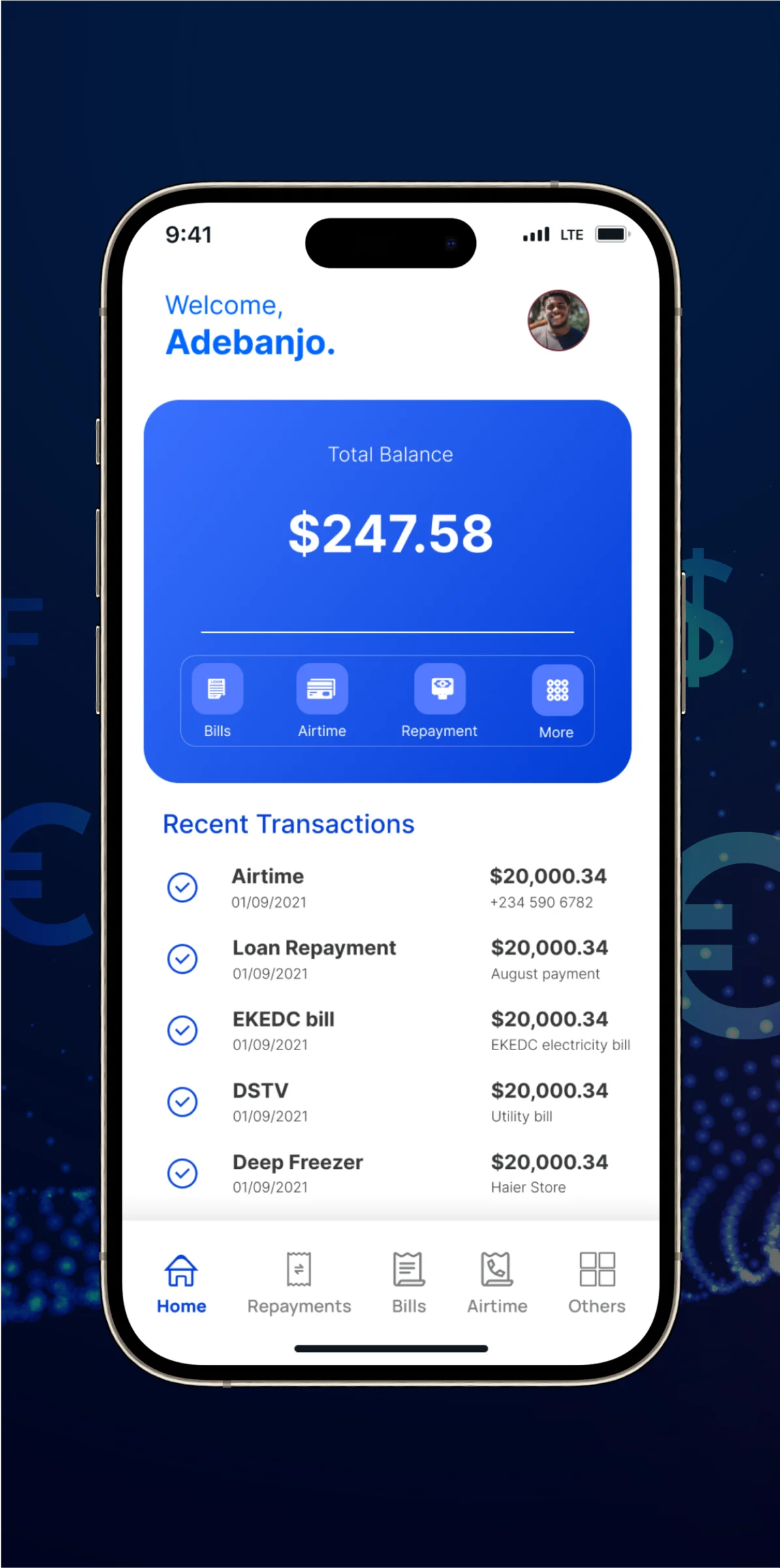
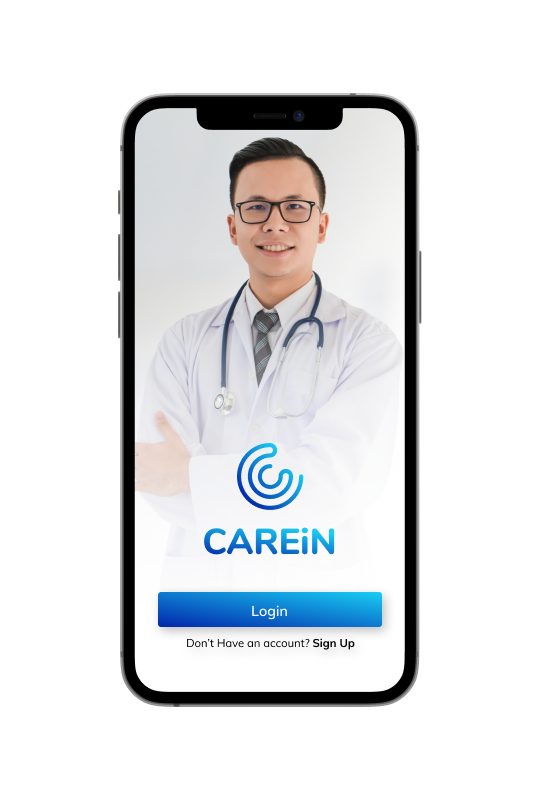
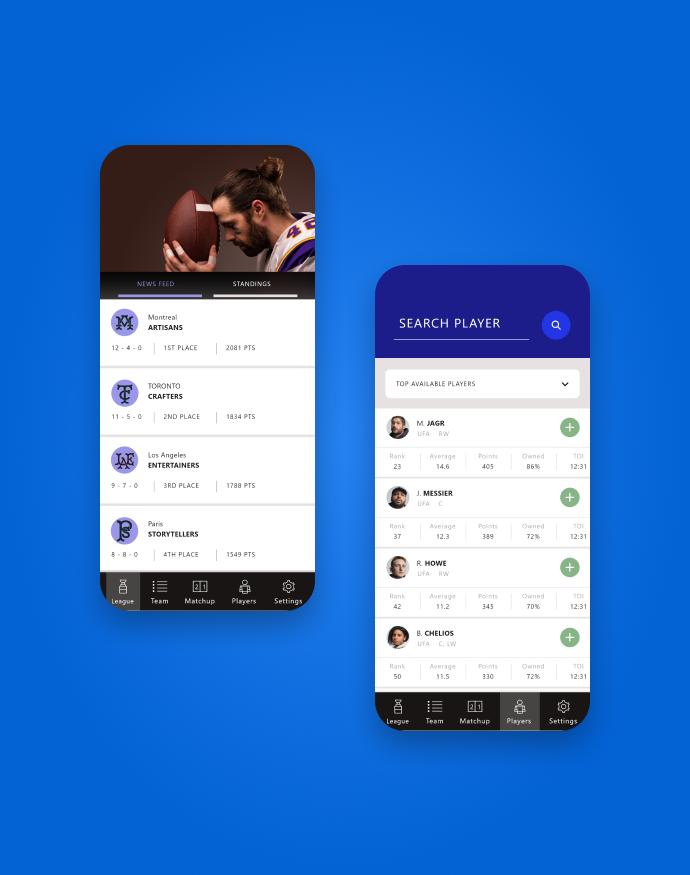



Vrinda Sharma